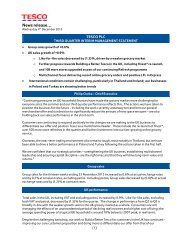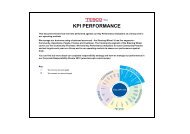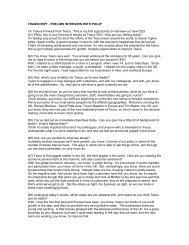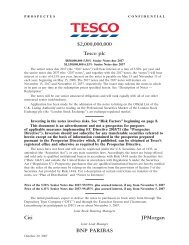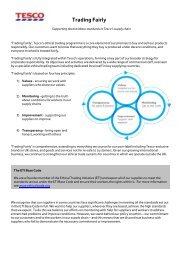Tesco plc Annual Report and Financial Statements 2008
Tesco plc Annual Report and Financial Statements 2008
Tesco plc Annual Report and Financial Statements 2008
Create successful ePaper yourself
Turn your PDF publications into a flip-book with our unique Google optimized e-Paper software.
Note 1 Accounting policies continued<br />
Pensions <strong>and</strong> similar obligations<br />
The Group accounts for pensions <strong>and</strong> other post-employment benefits<br />
(principally private healthcare) under IAS 19 ‘Employee Benefits’.<br />
In respect of defined benefit plans, obligations are measured at discounted<br />
present value (using the projected unit credit method) whilst plan assets<br />
are recorded at fair value. The operating <strong>and</strong> financing costs of such plans<br />
are recognised separately in the Group Income Statement; service costs<br />
are spread systematically over the expected service lives of employees <strong>and</strong><br />
financing costs are recognised in the periods in which they arise. Actuarial<br />
gains <strong>and</strong> losses are recognised immediately in the Group Statement of<br />
Recognised Income <strong>and</strong> Expense.<br />
Payments to defined contribution schemes are recognised as an expense<br />
as they fall due.<br />
Share-based payments<br />
Employees of the Group receive part of their remuneration in the form<br />
of share-based payment transactions, whereby employees render services<br />
in exchange for shares or rights over shares (equity-settled transactions)<br />
or in exchange for entitlements to cash payments based on the value of<br />
the shares (cash-settled transactions).<br />
The fair value of employee share option plans is calculated at the grant<br />
date using the Black-Scholes model. In accordance with IFRS 2 ‘Share-based<br />
payment’, the resulting cost is charged to the Group Income Statement<br />
over the vesting period. The value of the charge is adjusted to reflect<br />
expected <strong>and</strong> actual levels of vesting.<br />
Taxation<br />
The tax expense included in the Group Income Statement consists of<br />
current <strong>and</strong> deferred tax.<br />
Current tax is the expected tax payable on the taxable income for the year,<br />
using tax rates enacted or substantively enacted by the Balance Sheet date.<br />
Tax is recognised in the Group Income Statement except to the extent that<br />
it relates to items recognised directly in equity, in which case it is recognised<br />
in equity.<br />
Deferred tax is provided using the Balance Sheet liability method,<br />
providing for temporary differences between the carrying amounts of<br />
assets <strong>and</strong> liabilities for financial reporting purposes <strong>and</strong> the amounts<br />
used for taxation purposes.<br />
Deferred tax is calculated at the tax rates that have been enacted or<br />
substantively enacted by the Balance Sheet date. Deferred tax is charged<br />
or credited in the Group Income Statement, except when it relates to items<br />
charged or credited directly to equity, in which case the deferred tax is also<br />
recognised in equity.<br />
Deferred tax assets are recognised to the extent that it is probable that<br />
taxable profits will be available against which deductible temporary<br />
differences can be utilised.<br />
The carrying amount of deferred tax assets is reviewed at each Balance<br />
Sheet date <strong>and</strong> reduced to the extent that it is no longer probable that<br />
sufficient taxable profits will be available to allow all or part of the asset<br />
to be recovered.<br />
Deferred tax assets <strong>and</strong> liabilities are offset against each other when<br />
there is a legally enforceable right to set-off current taxation assets against<br />
current taxation liabilities <strong>and</strong> it is the intention to settle these on a<br />
net basis.<br />
Foreign currencies<br />
Transactions in foreign currencies are translated at the exchange rate on<br />
the date of the transaction. At each Balance Sheet date, monetary assets<br />
<strong>and</strong> liabilities that are denominated in foreign currencies are retranslated<br />
at the rates prevailing on the Balance Sheet date. All differences are taken<br />
to the Group Income Statement for the period.<br />
The financial statements of foreign subsidiaries are translated into Pounds<br />
Sterling according to the functional currency concept of IAS 21 ‘The Effects<br />
of Changes in Foreign Exchange Rates’. Since the majority of consolidated<br />
companies operate as independent entities within their local economic<br />
environment, their respective local currency is the functional currency.<br />
Therefore, assets <strong>and</strong> liabilities of overseas subsidiaries denominated in<br />
foreign currencies are translated at exchange rates prevailing at the date<br />
of the Group Balance Sheet; profits <strong>and</strong> losses are translated into Pounds<br />
Sterling at average exchange rates for the relevant accounting periods.<br />
Exchange differences arising, if any, are classified as equity <strong>and</strong> transferred<br />
to the Group’s translation reserve. Such translation differences are<br />
recognised as income or expenses in the period in which the operation<br />
is disposed of.<br />
Goodwill <strong>and</strong> fair value adjustments arising on the acquisition of a<br />
foreign entity are treated as assets <strong>and</strong> liabilities of the foreign entity <strong>and</strong><br />
translated at the closing rate.<br />
<strong>Financial</strong> instruments<br />
<strong>Financial</strong> assets <strong>and</strong> financial liabilities are recognised on the Group’s<br />
Balance Sheet when the Group becomes a party to the contractual<br />
provisions of the instrument.<br />
Trade receivables<br />
Trade receivables are non interest-bearing <strong>and</strong> are recognised initially<br />
at fair value, <strong>and</strong> subsequently at amortised cost using the effective<br />
interest rate method, reduced by appropriate allowances for estimated<br />
irrecoverable amounts.<br />
Investments<br />
Investments are recognised at trade date. Investments are classified as<br />
either held for trading or available-for-sale, <strong>and</strong> are recognised at fair value.<br />
For held for trading investments, gains <strong>and</strong> losses arising from changes<br />
in fair value are recognised in the Group Income Statement.<br />
For available-for-sale investments, gains <strong>and</strong> losses arising from changes<br />
in fair value are recognised directly in equity, until the security is disposed<br />
of or is determined to be impaired, at which time the cumulative gain or<br />
loss previously recognised in equity is included in the net result for the period.<br />
Interest calculated using the effective interest rate method is recognised<br />
in the Group Income Statement. Dividends on an available-for-sale equity<br />
instrument are recognised in the Group Income Statement when the<br />
entity’s right to receive payment is established.<br />
<strong>Financial</strong> liabilities <strong>and</strong> equity<br />
<strong>Financial</strong> liabilities <strong>and</strong> equity instruments are classified according to<br />
the substance of the contractual arrangements entered into. An equity<br />
instrument is any contract that gives a residual interest in the assets of<br />
the Group after deducting all of its liabilities.<br />
<strong>Tesco</strong> PLC <strong>Annual</strong> <strong>Report</strong> <strong>and</strong><br />
<strong>Financial</strong> <strong>Statements</strong> <strong>2008</strong> 49



